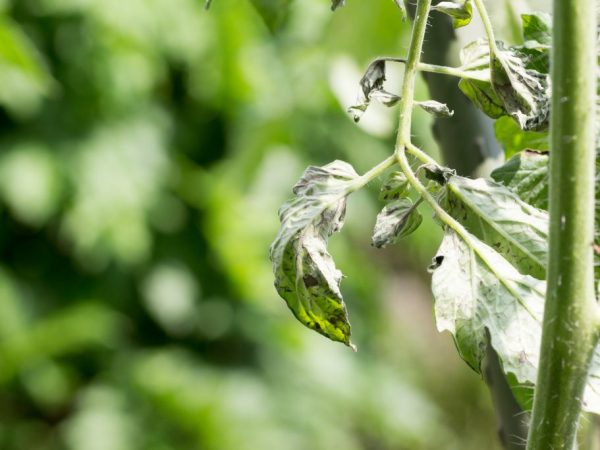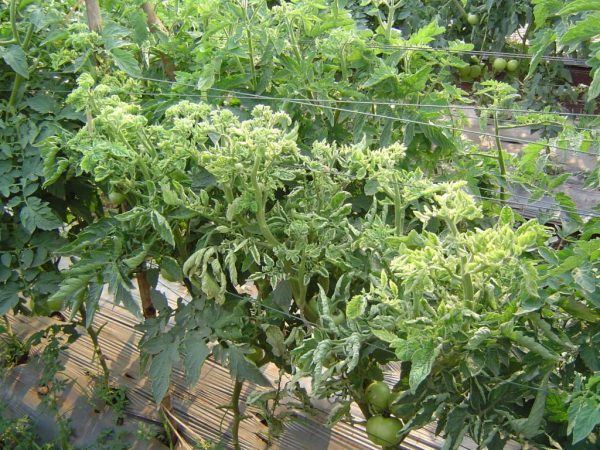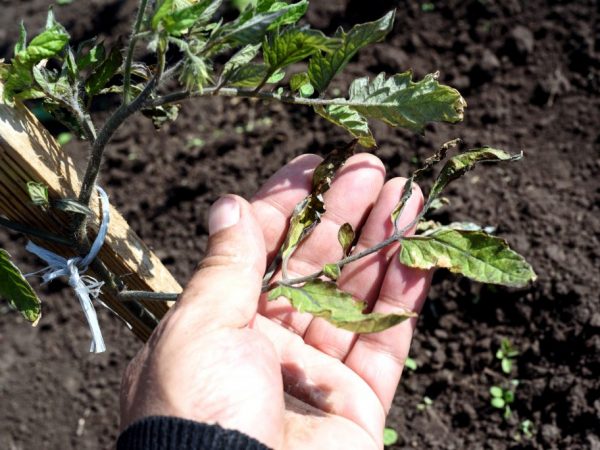Why do tomatoes curl leaves
There are many reasons why tomato leaves curl. Experienced summer residents, even with regular care of a vegetable crop, may encounter a problem when, for various reasons, the leaves of tomatoes are curling like a boat on the upper tops of tomato seedlings. Timely measures to save the plant allow you to avoid losses

Reasons for curling leaves in tomatoes
Bacteriosis
An infectious disease is one of the reasons why tomato leaves curl. Cancer is among the most common bacterial infectious diseases that cause the leaves of tomatoes to roll outward. Signs of infectious bacteriosis of tomatoes can be:
- shrinking young fresh leaves on the top of a tomato bush,
- decrease in the size of inflorescences,
- lack of ovaries,
- rolling the leaf blade down.
Infectious bacteriosis for tomatoes is a rather dangerous disease that causes verticillary wilting and death of all planted seedlings in a fairly short time.
Infected seeds and pests, including aphids and whiteflies, are the spreading agents of the bacterial infectious disease.
Treatment
It is almost impossible to cure leaf curling in tomato due to bacteriosis reasons. Most often, gardeners, instead of treating the disease, prefer to clean and remove damaged plants in order to avoid the rapid spread of bacterial infection to healthy tomato bushes. The soil is disinfected with antiseptics to remove pathogens of an infectious disease.
The most commonly used remedy for curing open soil infected with infectious bacteriosis is the drug Pharmayod, which kills the source of infection.
Watering disturbance
Among the non-infectious factors that can lead to curling of leaves in tomatoes, a violation of the irrigation procedure is called.
Lack of moisture
Lack of moisture is one of the possible reasons why the leaves of tomatoes curl up or down. This process occurs due to the plant saving the area of the leaf blade, from the surface of which moisture evaporates, and the bush begins to save the loss of liquid and fold up the foliage.
Treatment
In order to avoid the death of a vegetable crop, it is necessary to thoroughly water the lower part of the plant as soon as possible and adhere to the basic rules for the watering procedure in the future:
- water at least once every 7 days,
- be limited to two or three waterings even in severe dry weather,
- pouring at least 10 liters of water under each adult tomato bush,
- avoiding the ingress of moisture on the tops of the leaves and the lower parts of the stems of plants,
- reducing the amount of watering during the ripening of the fruits, which will certainly affect their integrity, otherwise they begin to crack,
- use for irrigation only with settled water at room temperature.
When the leaves of tomatoes curl, turn yellow and wither, it is not recommended to water the bushes right away. It is required to restore the required moisture level gradually.
Excess moisture

From an excess of moisture, the leaves curl up
If, with a lack of moisture, tomato leaves curl downward, then due to an excessive amount of water they turn yellow in the greenhouse and in the open field and the tomato leaves curl upward. Signs that tomatoes cannot handle too much liquid are:
- excessive moisture in the soil,
- fragility of the stems with no signs of lethargy.
An excess of moisture is often observed with long-term or heavy rainfall. The leaves of tomatoes curl in a greenhouse with increased humidity.
Treatment
In case of waterlogged soil, it is recommended:
- for a while, completely stop watering tomato bushes,
- in order to protect against precipitation, stretch a film over tomatoes grown in an open garden,
- if the humidity in the greenhouse is exceeded, do regular ventilation.
A properly prepared land for planting a vegetable crop allows to avoid problems with waterlogging of the soil. Tomatoes are planted in loose soil, for which large components, which include sand, sawdust or peat, are mixed into the soil before planting tomato seedlings. These components help to quickly absorb excess water, taking them into the deep layers of the soil.
When the planting areas are located in low-lying places, gardeners try to sprinkle a handful of river sand in each hole when planting tomatoes so that the root system is not constantly in the water.
Temperature violation
Tomato leaves begin to curl upward when the plant is in too hot temperature conditions. From the intense heat, especially in greenhouses, the tomato leaves of the upper and lower tiers wither and curl inward into tubes along the central leaf vein.
An indicator of leaf curling due to high temperature may be their freshness at night - the leaves begin to unfold spontaneously during the cool period of the day.
Treatment
For tomatoes grown in a greenhouse and on unprotected soil, immediate measures are taken to restore the state of the foliage:
- the greenhouse is ventilated and a draft is set up,
- mulch the soil with a thick layer of organic matter, including sawdust, straw, needles, humus,
- creating a shadow on top of tomato bushes by using a covering material,
- daily spraying in the evening of urea in a proportion of 1.5 tbsp. l. for a 10-liter volume of liquid or a weak solution with potassium permanganate,
- regularly conducted watering.
Wrong groundbait
Improper nutrition of tomatoes is also one of the reasons for the violation of the appearance of foliage.
Lack of fertilizer

Lack of fertilizer affects the appearance of the leaves
Insufficient supply of mineral elements for tomatoes results in twisting and wilting of leaves. The appearance of the plant allows you to determine which nutrients are lacking in tomato bushes:
- when the leaves curl downward and turn gray-green with bright purple or red central veins, this is a sign that the tomatoes are lacking in the phosphorus component,
- if fresh young leaves curl upward from the edge to the middle of the leaf blade, become curly at the top, then sluggish, and the vegetables are covered with white spots, this is due to a lack of potassium.
Treatment
To cure tomato bushes from twisted leaves is simple: just add a groundbait with missing nutrients. For this purpose, superphosphate, potassium nitrate and other fertilizers containing phosphorus and potassium are suitable.
A good top dressing, which includes the necessary useful elements for feeding tomato bushes, is simple wood ash. Watering and spraying plants with water-diluted ash is a quick fix for wilted tomato foliage.
Excess fertilizer
Over-fertilization of the soil can also become a provoking reason why the leaves of tomatoes curl. This usually happens when there is a lot of nitrogen in the ground. A sign of excess nitrogen along with twisted leaves is a thickening of the plant stem and shrinking of tomato inflorescences or their complete absence on tomato bushes.
Treatment
Abundant irrigation with plain water allows to reduce the amount of nitrogen-containing component contained in the soil.
Pinching violation
The formation of tomato bushes is not required for all varieties of tomatoes, however, in species that need pinching, failure to follow this procedure may be the reason why the leaves of the tomatoes are curled. If the rules for the formation of bushes are violated, including when many shoots are removed at once during pinching, or overgrown shoots that have reached a length of 5 cm or more are cut off, the plant experiences significant stress. As a result, the tomato bush twists its leaves, and sometimes it can shed flowers and even get rid of the ovaries.
Treatment
When pinching, it is required to follow the basic rules for the formation of tomato bushes:
- young shoots that have not reached 5 cm in length are removed,
- too short stepsons do not break off, because a fresh wound is healed faster if it is formed with the remaining part of about 1 cm,
- pinching is carried out in the morning to allow fresh cuts to dry out and weather before evening,
- before pinching, the tomatoes are watered, which makes the stem more fragile and brittle, and the process of tearing off the shoots is less laborious and traumatic.
In the case of an existing violation of the pinching procedure, it is possible to restore the plants by improving their care, including the ventilation of the greenhouse premises, proper watering and feeding using biostimulants.
The presence of pests
Insects present on tomato bushes: aphids, spider mites, whiteflies - become the reason why tomato leaves curl. Insects suck out all the juice from the leaf blade, it becomes thinner and lifeless, dries up and curls up into a tube.
If the plant tops are damaged by pests, other signs can be added along with curliness - yellow spots appear.
Treatment
The initial measures against pests are insecticide spraying. Such preparations are suitable when there are no ovaries on the bushes yet. When fruits ripening on tomato branches, it is recommended to use biological agents and folk recipes for herbal infusions. The most effective are wormwood, ragweed and other weeds.


